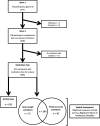Association of Drug Burden Index with grip strength, timed up and go and Barthel index activities of daily living in older adults with intellectual disabilities: an observational cross-sectional study
- PMID: 31234775
- PMCID: PMC6591943
- DOI: 10.1186/s12877-019-1190-3
Association of Drug Burden Index with grip strength, timed up and go and Barthel index activities of daily living in older adults with intellectual disabilities: an observational cross-sectional study
Abstract
Background: Drug Burden Index (DBI), a measure of exposure to medications with anticholinergic and sedative activity, has been associated with poorer physical function in older adults in the general population. While extensive study has been conducted on associations between DBI and physical function in older adults in the general population, little is known about associations in older adults with intellectual disabilities (ID). This is the first study which aims to examine the association between DBI score and its two sub-scores, anticholinergic and sedative burden, with two objective measures of physical performance, grip strength and timed up and go, and a measure of dependency, Barthel Index activities of daily living, in older adults with ID.
Methods: Data from Wave 2 (2013/2014) of the Intellectual Disability Supplement to the Irish Longitudinal Study on Ageing (IDS-TILDA) was analysed. Analysis of Covariance (ANCOVA) was used to detect associations and produce adjusted means for the physical function and dependency measures with respect to categorical DBI scores and the anticholinergic and sedative sub-scores (DBA and DBS).
Results: After adjusting for confounders (age, level of ID, history of falls, comorbidities and number of non-DBI medications, Down syndrome (grip strength only) and gender (timed up and go and Barthel Index)), neither grip strength nor timed up and go were significantly associated with DBI, DBA or DBS score > 0 (p > 0.05). Higher dependency in Barthel Index was associated with DBS exposure (p < 0.001).
Conclusions: DBI, DBA or DBS scores were not significantly associated with grip strength or timed up and go. This could be as a result of established limitations in physical function in this cohort, long-term exposure to these types of medications or lifelong sedentary lifestyles. Higher dependency in Barthel Index activities of daily living was associated with sedative drug burden, which is an area which can be examined further for review.
Keywords: Ageing; Anticholinergic; Barthel index; Drug burden index; Grip strength; Intellectual disability; Medication; Physical function; Sedative; Timed up and go.
Conflict of interest statement
The authors declare they have no competing interests.
Figures











Similar articles
-
Drug burden index to define the burden of medicines in older adults with intellectual disabilities: An observational cross-sectional study.Br J Clin Pharmacol. 2018 Mar;84(3):553-567. doi: 10.1111/bcp.13479. Epub 2018 Jan 5. Br J Clin Pharmacol. 2018. PMID: 29193284 Free PMC article.
-
Impact of drug burden index on adverse health outcomes in Irish community-dwelling older people: a cohort study.BMC Geriatr. 2019 Apr 29;19(1):121. doi: 10.1186/s12877-019-1138-7. BMC Geriatr. 2019. PMID: 31035946 Free PMC article.
-
Drug Burden Index associated with function in community-dwelling older people in Finland: a cross-sectional study.Ann Med. 2012 Aug;44(5):458-67. doi: 10.3109/07853890.2011.573499. Epub 2011 Apr 15. Ann Med. 2012. PMID: 21495785
-
Inappropriate medications and physical function: a systematic review.Ther Adv Drug Saf. 2021 Jul 16;12:20420986211030371. doi: 10.1177/20420986211030371. eCollection 2021. Ther Adv Drug Saf. 2021. PMID: 34349978 Free PMC article. Review.
-
Drug Burden Index in older adults: theoretical and practical issues.Clin Interv Aging. 2014 Sep 9;9:1503-15. doi: 10.2147/CIA.S66660. eCollection 2014. Clin Interv Aging. 2014. PMID: 25246778 Free PMC article. Review.
Cited by
-
Nature and extent of intellectual disability nursing research in Ireland: a scoping review to inform health and health service research.BMJ Open. 2021 Oct 6;11(10):e051858. doi: 10.1136/bmjopen-2021-051858. BMJ Open. 2021. PMID: 34615681 Free PMC article.
-
Psychotropic medicines' prevalence, patterns and effects on cognitive and physical function in older adults with intellectual disability in Ireland: longitudinal cohort study, 2009-2020.BJPsych Open. 2024 Feb 1;10(2):e39. doi: 10.1192/bjo.2023.607. BJPsych Open. 2024. PMID: 38297892 Free PMC article.
-
The adverse effects of long-term exposure to anticholinergics among people with intellectual disabilities: a scoping review.HRB Open Res. 2022 Sep 30;5:63. doi: 10.12688/hrbopenres.13599.1. eCollection 2022. HRB Open Res. 2022. PMID: 37396688 Free PMC article.
-
Effects of medical insurance system on the hospitalization cost of acute myocardial infarction patients.Cost Eff Resour Alloc. 2022 Feb 22;20(1):8. doi: 10.1186/s12962-022-00343-6. Cost Eff Resour Alloc. 2022. PMID: 35193603 Free PMC article.
-
Socioeconomic Inequality and Risk of Sarcopenia in Community-Dwelling Older Adults.Clin Interv Aging. 2021 Jun 17;16:1119-1129. doi: 10.2147/CIA.S310774. eCollection 2021. Clin Interv Aging. 2021. PMID: 34168435 Free PMC article.
References
-
- American Psychiatric Association. Diagnostic and statistical manual of mental disorders. 5th ed. Arlington, VA: American Psychiatric Publishing; 2013.
Publication types
MeSH terms
Substances
LinkOut - more resources
Full Text Sources
Medical

